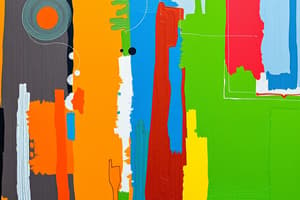Podcast
Questions and Answers
What are the fundamental components used by artists when creating a work of art?
What are the fundamental components used by artists when creating a work of art?
Line, shape, value, colour, space, texture, and form.
Which of the following are types of lines used in art?
Which of the following are types of lines used in art?
- Straight
- Curved
- Angular
- All of the above (correct)
Shapes in art can only be geometric.
Shapes in art can only be geometric.
False (B)
What is value in art?
What is value in art?
Who created the value scale and in what year?
Who created the value scale and in what year?
Which technique involves using highly contrasting light and dark values in art?
Which technique involves using highly contrasting light and dark values in art?
The primary colours are red, blue, and ______.
The primary colours are red, blue, and ______.
How can colours evoke feelings in people?
How can colours evoke feelings in people?
What types of materials are commonly used in Art/Design?
What types of materials are commonly used in Art/Design?
Dry materials can be used separately or in various combinations.
Dry materials can be used separately or in various combinations.
Which of the following is the oldest drawing tool?
Which of the following is the oldest drawing tool?
Coloured pencils are used to draw fine, coloured ______.
Coloured pencils are used to draw fine, coloured ______.
What are oil pastels made from?
What are oil pastels made from?
Which type of ink is commonly used for drawing comics?
Which type of ink is commonly used for drawing comics?
All inks can only be used full strength.
All inks can only be used full strength.
What elements can influence an artist's choice of paint?
What elements can influence an artist's choice of paint?
Felt pens and markers are excellent for ______ and design.
Felt pens and markers are excellent for ______ and design.
Flashcards are hidden until you start studying
Study Notes
Importance of Art
- Studying art enhances visual literacy and critical thinking skills.
- Engages emotional responses and encourages creative expression.
Elements of Art
- Fundamental components include line, shape, value, color, space, texture, and form.
- These elements combine to create composition and convey meaning.
Lines
- Basic element; can be straight, curved, angular, or organic.
- Varying thickness can convey direction, movement, value, and texture.
- Line art utilizes techniques like hatching or cross-hatching to simulate light and shadow.
Shape
- Two-dimensional forms with defined outlines; can be geometric or organic.
- Complex shapes attract more attention than simple ones; larger shapes have greater visual weight.
- Example: William Morris used repeated complex shapes for intricate patterns.
Value
- Refers to the lightness or darkness of a color, crucial for depth and perspective.
- Created by mixing black or white with a color; related to Denman Ross's value scale (1=white, 9=black).
- Chiaroscuro technique utilized by artists like Caravaggio highlights contrasting light and dark.
Color
- Essential for bringing vitality to art; perception based on hue, saturation, and luminance.
- Primary colors (red, blue) mix to form secondary and tertiary colors.
- Colors evoke emotions and can express the artist's state; color theory explores these applications in art.
Tools, Equipment, and Materials in Art/Design
- A diverse range of tools, equipment, and materials are essential in Art/Design and Communication.
- These materials can be costly and require proper care; students share supplies and must handle them responsibly.
- Craftspeople and artists utilize various tools creatively, affecting the final object or design.
Dry Materials for Making Marks
- Dry Materials: Examples include pencils and charcoal, which can be used independently or in combination for richer textures.
- Coloured Pencils: Used for fine lines and shading; artists can blend and layer different colours creatively.
- Charcoal: An ancient drawing medium made from burnt wood, available in various forms (e.g., pencil, compressed sticks). Differences in hardness produce varied effects.
- Conté: A compressed chalk that comes in various densities and only in earth tones (white, black, browns, greys, rust).
- Oil Pastels: Compressed chalk with oil, available in numerous colours; layering can create soft, blended effects.
Wet Materials for Making Marks
- Wet Materials: Include ink and paint, which can be mixed for complex textures.
- Felt Pens and Markers: Suitable for layout and design, but transparency limits their effectiveness for large colour areas.
- India Ink: Conventional black ink used for drawing, especially in comics. It can be diluted for wash effects and applied with various tools (nib pens, brushes).
- Types of Paint: Artists select paint based on colour, effects, drying time, and the surface used.
Tools for Applying Materials
- A wide range of tools is utilized for marking with dry and wet materials, including:
- ballpoint pens
- felt-tipped pens
- fountain pens
- lettering pens
- technical pens
- nib pens
- brushes
- unique found objects (e.g., twigs, feathers)
Studying That Suits You
Use AI to generate personalized quizzes and flashcards to suit your learning preferences.




